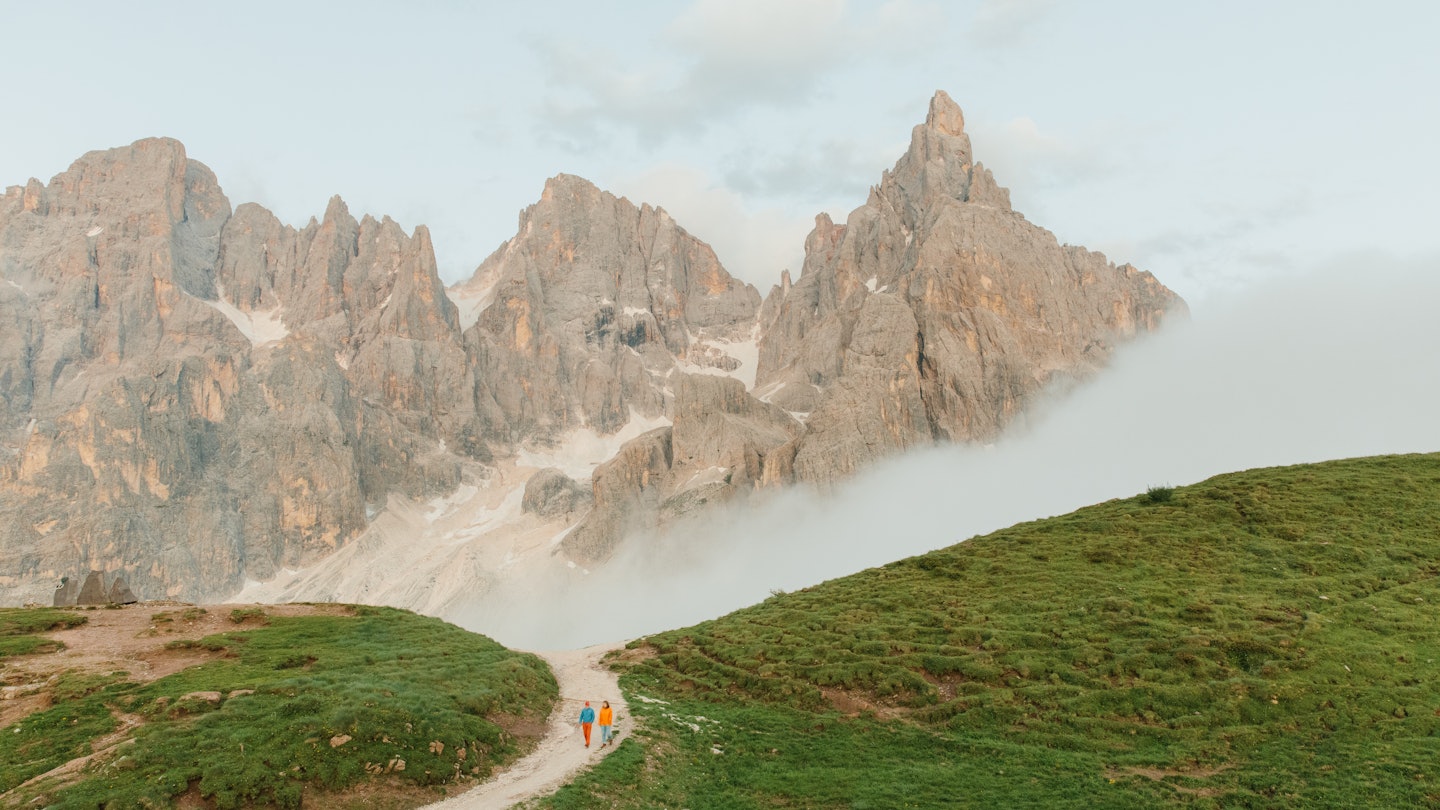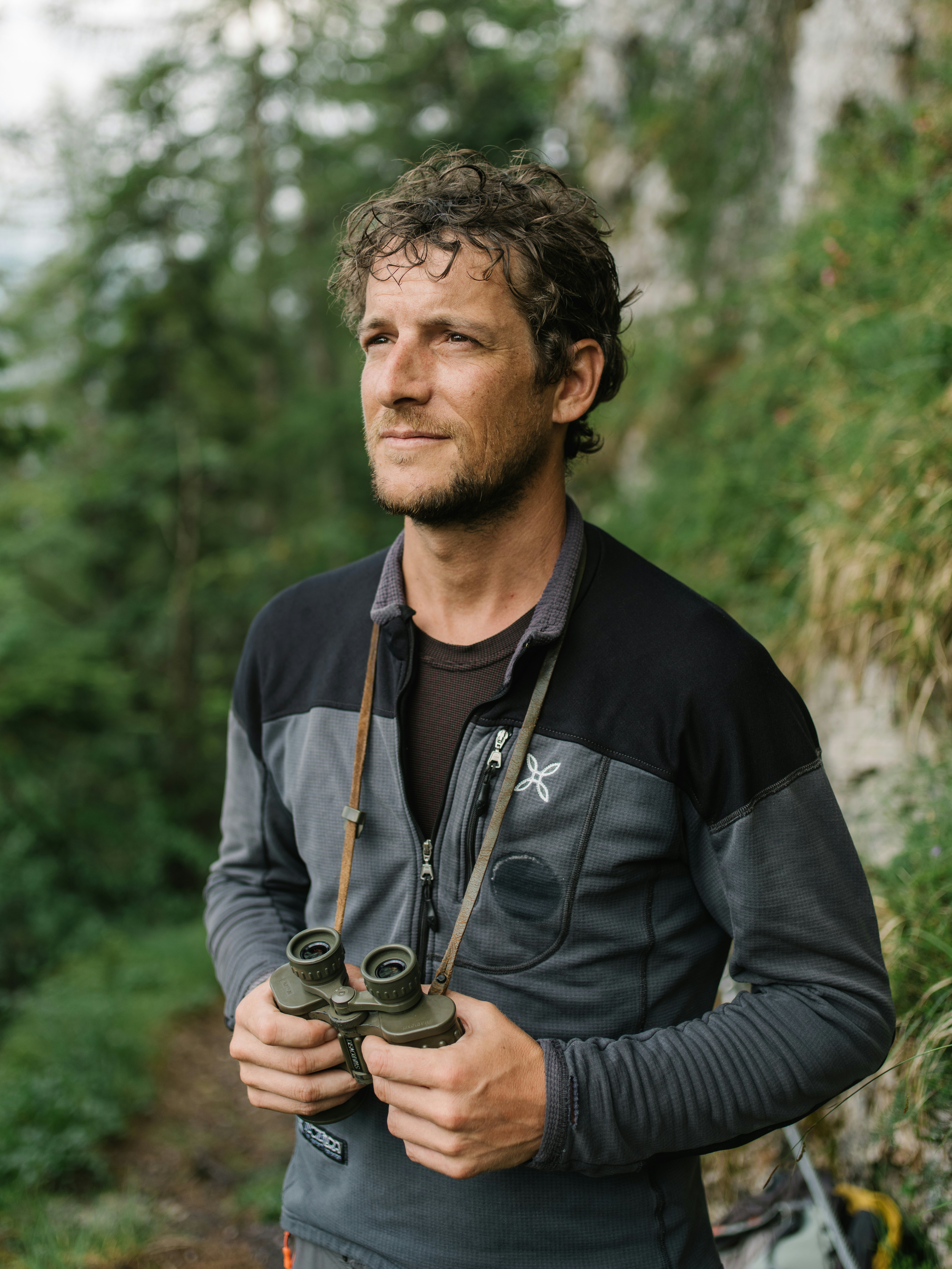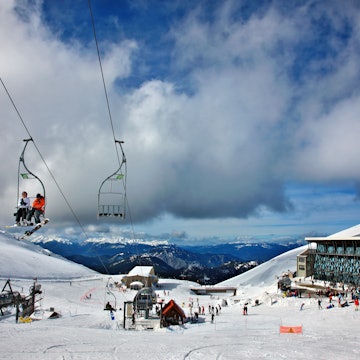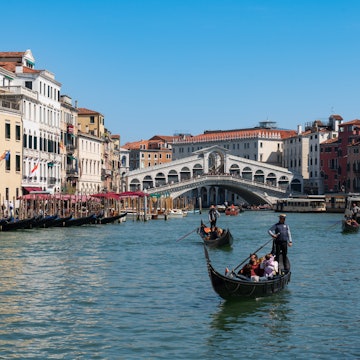

Orla Thomas and guide Narciso Simion walking near Pale di San Martino © Kevin Faingnaert / Lonely Planet
Extraordinarily scenic, the Dolomites draw hikers of all abilities to Northern Italy. Though there are ample opportunities for solitude, a walk with an in-the-know local will help to unlock the secrets of the "pale mountains."
Stroll through history to a hilltop castle
Arco Castle looks lifted from a fairy tale. Medieval, perched on a rocky spur and surrounded by cypress trees, it seems a good spot to hide a princess or hidden treasure. Eager to find out which, I set out one morning from Arco, the town that sits in its shadow, in the company of local historical guide Laura Tessaro.
"I’m afraid I only have two gears – fast or slow," she says, opting for the more sedate speed as we meander through the main piazza, bathed in morning sun. A church bell tolls the hour as we make our way down a cobbled side street lined with laundry-strewn balconies, one trailing the blooming tendrils of a passion fruit plant.

Though less than an hour from Lake Garda and just as pretty as the towns on its shores, Arco attracts only a handful of visitors.
"Here we are between the lake and the mountains," says Laura. "I like this town – it has stayed authentic."
Those who do visit rarely miss the walk up to the castle. There are five slightly different ascents – some take in the town’s arboretum, abundant with Mediterranean vegetation, others pass through groves of olive trees; some climb steeply, others zig-zag up. Arco Castle’s position above the valley was strategic, Laura tells me – so successive generations of noble occupants could see who was coming.
Now, only ruins hint at its original structure. The excavation of one of the castle’s collapsed towers revealed something particularly special, a room decorated with 14th-century frescoes on an unusual theme – the education of women. Peering at the faded paintings in the gloom, I see comely maidens progress from playing dice to checkers, from backgammon to chess. In the final sequence, a young student wins a game against her teacher.
"Can you imagine?" says Laura. "At this time! When all of the power was with men." It is indeed a treasure, and a satisfyingly anachronistic ending to my fairy tale quest.
Book a tour with Laura at Mercuria Guides.
Stretch your legs and search for bears with a park ranger
"During my teenage years my friends would be down at Lake Molveno, hanging out with girls – but I’d always be here, alone, walking in the mountains," says Michele Zeni, who works for Adamello Brenta Nature Park. Little has changed in two decades, except now he gets paid to devote himself to the natural world. Michele looks rather like Bear Grylls, but has a softness of manner that is all his own.
"When you’re out on your own you’re quieter," he says. "So you see more animals." His big passion is for bears. His eyes light up as he recalls that first sighting, or the four hours he spent tracking a mother and cubs. "For ancient people the bear was a magical creature," he says. "They died every winter and were resurrected in spring – like Jesus."

The weather turns biblical as we set out from Malga Dagnola Bassa, a remote mountain hut in the nature park, but abundant trees provide cover. Spruce and larch cones litter our path, alongside nests that red wood ants have built from leaves. Michele pats one nest gently, encouraging me to follow suit, and afterwards our hands smell like vinegar – the acid the ants have sprayed as defense. As we trudge higher, Michele occasionally points out – in a near- whisper – a rare flower, such as the protected martagon lily.
"Every meter you go up, you see fewer signs of humans," he says with satisfaction.
The path reaches Malga Dagnola Alta, a hut in a clearing with views to the top of a peak named Piz Galin. Michele tells me this kind of rock is full of small caves that bears use for hibernation, and offers his binoculars to scan for signs of life – if not bears, then perhaps a chamois or a ptarmigan. I squint and search in vain.
"There are animals here, but they’re shy," Michele says, adding that their invisibility is a good thing. "A confident bear is a dead bear – those that come too close will be killed by a hunter, so the animals that survive are the shy ones." There are as many as 70 brown bears in this part of the Central Alps, and Michele is content with only rare glimpses of them – so long as they remain safe.
Find out more about the Adamello Brenta Nature Park and its program of activities.
Climb into the mountains with an Alpine guide
As the Grostè cable car gains altitude, I feel my anxiety levels rise at a similar trajectory. I am here to tackle my first via ferrata or "iron way:" one of a global network of mountain paths made more accessible by cables and ladders. Via ferrata started in the Alps and have great significance in the Dolomites, where Italian and Austro-Hungarian soldiers made the paths as they vied for dominance in this key WWI battleground.
Nearing the start of Sentiero Vidi, a beginner’s route in the northern Brenta Dolomites, my own battle is with nerves. "It’s my job to make people relax," says Alpine guide Silvestro Franchini as he fits my harness. A former skier on Italy’s national team, he is a man clearly at ease in the mountains.
"A via ferrata is not hiking, but it’s not climbing either – it’s somewhere in the middle."
We begin easily but the terrain quickly steepens, the narrow path ascending through an increasingly tree-less landscape that becomes almost lunar in its barren grayness. Reaching an area that feels more exposed, Silvestro connects us with a rope, explaining how he’ll keep me safe if I lose my footing, and giving me tips for the route.
"You climb first with your mind," he says. "Next, with your feet – and only at the end with your hands."
We make our way along a promontory, a dizzying drop on each side, clipping carefully to the metal wire at our waist. On the other side are the only other people we encounter: a cheery septuagenarian tackling the path with his 16-year-old grandson.

Ascending a ladder through cloud, we arrive at open ledges at the base of Pietra Grande (2937m/9636ft). The striations in the rock are as clear as tiger stripes.
"Each layer represents a different age," says Silvestro. "Another page in the mountains’ history book."
Continuing on the path, I realize that being so high up has started to feel almost normal. I enjoy the majestic views over the valley rather than foresee a tumble into them. Without the sound of my own pulse beating in my ears, I begin to notice other sounds, too: the whistling of a marmot, the distant clanking of a cowbell.
Beginning our descent, we pause at the top of a scree slope, where Silvestro takes me by the hand. "It’s time to let go of your fear!" he says, and guides me in giant leaps down the rubble, tiny fragments of shale cascading in miniature landslides. When we reach the bottom, a meadow full of wildflowers, I sink gratefully into the grass, resting my head among edelweiss and the chocolate-smelling blossoms of nigritella.
Book an excursion with Silvestro via Guide Alpine Campiglio.
Forage for edible treasures with the "lady of the herbs"
There’s only one way to reach traditional mountain guesthouse Rifugio Nambino: on foot. From a woodland car park near the resort town of Madonna di Campiglio, the steep path winds upwards through dense forest, following a rushing stream that cascades over mossy boulders.
After 20 minutes I find its source: Lago Nambino, the meltwalter-fed lake that gives the guesthouse its name, sunlight shimmering on its surface. The pretty wooden chalet shares the shoreline with only one other dwelling: tucked away among the trees, a small house with squat chimneys and wooden shutters.
This is the home of Eleonora Cunaccia, known to her friends as Noris, and to others as the "lady of the mountains." Noris lives here all summer, and spends her days searching for wild herbs and other edibles, which she supplies to restaurants and turns into products to sell online.

For years Noris was a restaurateur, working all hours at her Michelin-starred business, but pursued a new direction when she and her husband divorced.
"I chose this life," Noris explains, as she pours me a cup of fresh mint tea, insisting that I take a slice of her juicy carrot cake. "I love the freedom of being in the woods, of working in a natural environment."
She hands me a wicker basket and we set out. Noris rarely moves more than a few steps before dipping to the ground for another discovery: wild spinach and watercress, parsley and tiny pink strawberries. In a field full of purple-flowering thyme she scampers ahead of me like an excitable elf, pulling up great armfuls.
"Yesterday I made a soup with this," she tells me with obvious pride. "Each day, I see what new things nature has for me, and I wonder – how can I use this?"
Noris’s products can be bought from her online shop Primitivizia.
Work up an appetite exploring a dairy farm
The cows of Malga Juribello, near the mountain resort of San Martino di Castrozza, are enjoying their summer holiday. This herd of Bruna Alpina, Pezzata Rossa and Holstein Friesian cattle spend June to September away from their usual lowland farms, grazing on the superior grasslands at 1900m (6234ft). They are nonplussed as I approach on foot with farmer Claudio Valorz, who’s been taking care of this malga – a word which translates both as "mountain pasture" and "mountain hut" – for nearly two decades.
"I’m retired now," he admits, "but I come anyway, for pleasure. Every year, the mountains call me back."
It’s easy to see why. The Pale di San Martino range looms over vivid green fields, creating a scene of such bucolic loveliness it could be a backdrop to a chocolate commercial. Straight out of central casting is a strapping teenage agricultural student, sat on a stool to demonstrate hand-milking. Although it’s rarely used these days, most farmers still take pride in doing it well.
"Among the young, there is a new enthusiasm for agriculture," says Claudio. "Instead of moving to the cities, more are staying on the land and working using new technologies."

As well as the 150 cattle, Malga Juribello keeps sheep, pigs, rabbit and goats.
"Our real purpose has always been as a teaching farm," says Claudio. "To show people these practices, to share our way of life."
We end our walk in the simple restaurant, where breakfast is laid out. I try their hard cheese, its sharp and salty taste offset by honey. I devour pots of yogurt with chestnuts in syrup. Perhaps most outstanding of all is the butter, which I slather on slices of bread. With a rich yellow hue lent by high levels of beta carotene in the Alpine grass – and the many herbs and wildflowers that the cows devour with it – it is the butteriest butter I have ever tasted, the purity of the mountains distilled into a single bite.
Make it happen
GETTING THERE AND AROUND
Verona is the nearest airport to the Trentino Dolomites, but you could also consider flying into other nearby Italian cities such as Milan and Venice – or travel via Innsbruck in Austria. As public transport is limited in this rural location, you’ll need to pick up a hire car at the airport.
WHERE TO STAY
The Trentino Dolomites have a number of authentic mountain refuges, which are wonderful places to absorb the special atmosphere of the region and sample the unique local cuisine – which is more Alpine than typically Italian. Book a balcony room at Rifugio La Montanara for a front-row view of the peaks and don’t miss a stay at lakeside Rifugio Nambino. In Arco, Garni On the Rock makes a good base, while in San Martino di Castrozza we recommend Hotel Cima Rosetta.
FURTHER INFORMATION
The official tourist board website is packed with inspiration as well as useful trip-planning tips. Some regions within the Trentino Dolomites, such as Madonna di Campiglio, also have good sites.
Orla Thomas traveled to the Dolomites with support from Visit Trentino. Lonely Planet contributors do not accept freebies in exchange for positive coverage.
You might also like
Why Alaska's stunning coast is best seen by ferry
I fled civil war. Now I travel the world
With travel ground to a halt, a writer rediscovers home















